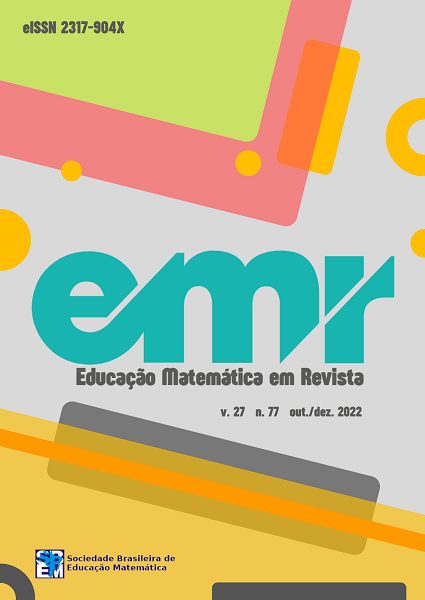Contavox: the blind view of Mathematics
DOI:
https://doi.org/10.37001/emr.v27i77.2937Keywords:
Mathematics, Students, Contavox, OperationsAbstract
This article is na excerpt of the resulto f the master’s research that was developed with the educational game Contavox, designed for the learning of the four fundamental operations of Mathematics with blind people. The main objective was to analyze the evidence of involvement and learning in the teaching processo f the four fundamental operations of Mathematics, using the game Contavox. The theoretical framework is based on the studies of Professor José Antônio Borges, creator of the Dosvox System, host of the Contavox game, ando on the work developed by the Eletronic Computing Center of the Federal University of Rio de Janeiro. The methodological procedures were carried out through the use of computers, with the proper intallation of the Dosvox System, and handling of the Contavox game; from the observation of the teaching and learning processo f the participating students and from a recorded interview with their reports of perception of the results achieved with the use of the game. Contavox, with the accomplishment of this research, became another innovative source of Mathematics learning in the school context.
Downloads
References
BORIN, J. JOGOS E RESOLUÇÃO DE PROBLEMAS: Uma estratégia para as aulas de matemática. 2. ed. São Paulo: IME-SP, 1996.
BORGES, J. A. Dosvox: um novo horizonte para deficientes visuais. Rev. Técnica do Instituto Benjamin Constant, nº 03, 1997. José Antonio dos Santos Borges.
BORGES, J.A. Do Braille ao Dosvox: diferenças nas vidas dos cegos brasileiros. 2009. 343f. Tese (Doutorado em Engenharia de Sistemas e Computação). Universidade Federal do Rio de Janeiro, 2009.
CARDOSO, D. R.; D'ASCENZI, I. F.; MONSERRAT NETO, J. DOSVOX: a História da Revolução entre os Cegos. Universidade de São Paulo, 2013. DisponÃvel em: http://intervox.nce.ufrj.br/DOSVOX/textos/historia_do_DOSVOX.pdf. Acesso em:03 julho 2020.
DANTE, L.R. Didática da Resolução de Problemas de Matemática. 2ªed. São Paulo: Ãtica, 1998.
GIL, A. C. (1994) Como elaborar projetos de pesquisas. São Paulo: Editora Atlas.
GIARETA, L. A. S. O papel da tecnologia assistiva na inclusão digital dos portadores de
deficiência visual. In: I SIMPÓSIO DE CIÊNCIAS INTEGRADAS DA UNAERP CAMPUS
GUARUJÃ, 2004, São Paulo. Anais... São Paulo: UNAERP, 2004.DisponÃvel em:
https://www.unaerp.br/index.php /documentos/836-o-papel-da-tecnologia-assistiva-na-inclusao-
digital-dos-portadores-de-deficiencia-visual/file>. Acesso em: 03 julho 2020.
SETUVAL, Francisco; BEJARANO, Nelson. Os modelos didáticos com
conteúdos de genética e a sua importância na formação inicial de professores para o ensino de ciências e biologia. Bahia, 2008. DisponÃvel em: http://fep.if.usp.br/~profis/arquivos/viienpec/VII%20ENPEC%20-%202009/www.foco.fae.ufmg.br/cd/pdfs/1751.pdf. Acesso em 12 de junho de 2021.
TRINDADE, D. C. O lúdico na pedagogia com portadores de necessidades especiais  PNE's. HOLOS, Ano 20. Outubro de 2004. UNESCO.
VALENTE, J. A. As tecnologias digitais e os diferentes letramentos. Revista Pátio. Porto Alegre, RS, v. 11, n. 44, nov. 2007.
Published
How to Cite
Issue
Section

This work is licensed under a Creative Commons Attribution-NonCommercial-ShareAlike 4.0 International License.






